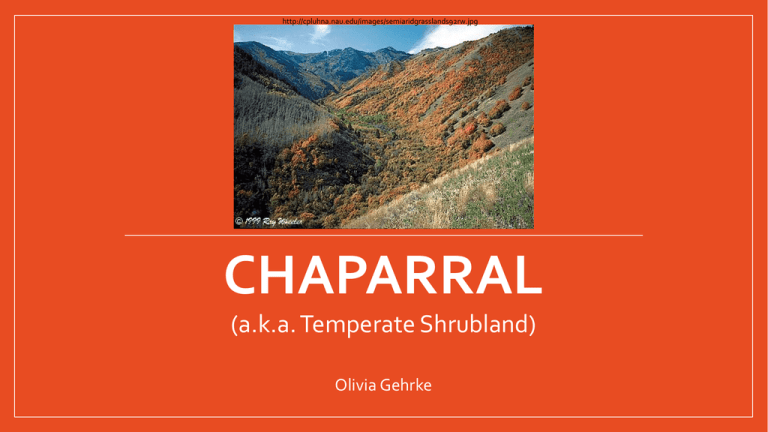Chaparral Ecosystem - CarrollEnvironmentalScience
advertisement

http://cpluhna.nau.edu/images/semiaridgrasslands92rw.jpg CHAPARRAL (a.k.a. Temperate Shrubland) Olivia Gehrke • Typically found in coastal regions that are bordered by deserts • Ex) • • southern California Mediterranean http://www.anselm.edu/homepage/jpitocch/genbi101/34_08TerrestrialBiomes-L%20copy.jpg Overview • Abiotic • Rocky • Lots of constant sunlight • Many hills • Biotic • Temperate shrubland • Dense growths of • • Low-growing evergreen shrubs Small trees with leathery leaves (reduce evaporation) http://www.californiachaparral.org/images/555_PS-Chamise-RS-chaparral.jpg Climate • Mild, moist, but doesn’t get a lot of precipitation • 10-17 inches per year (mostly in winter) • Summer=hot & dry • Temperature usually mild but sometimes reaches hot/cold extremes • Average range: 30-70 degrees Fahrenheit http://betterphoto.typepad.com/.a/6a00e5501d97a488330147e0f07ee8970b-800wi Soil • Thin, rocky layer on top of subsoil • Subsoil consists of clay or rock that holds moisture • Needs to hold moisture b/c summers in the chaparral can be very dry • Plants use moisture in the soil due to the limited amount of precipitation http://1.bp.blogspot.com/_wWY3RnqSbnU/S_TJlorkiDI/AAAAAAAAAFU/OKv8UzJEcq8/s1600/chaparral.JPG Dominant Plants • Blue oak • Coyote brush • Common sagebrush • manzanita http://ucanr.edu/sites/scmg/files/30291display.jpg http://www.igoterra.com/photo/999/012115.JPG Plant Adaptations • Chaparral biome is known for having periodic fires, so some plant life has adapted to tolerate the fires. • Some plants are fire resistant • • Plants have seeds that mostly sprout following a fire • • Coyote brush leaves’ chemical make-up prevents them from catching fire Fire poppy Plants have to adapt to large variations in temperature • Blue oak can survive at 100 degrees Fahrenheit for several weeks http://www.laspilitas.com/images/grid24_24/3470/s/images/plants/304/Eschscholzia_californica-4.jpg Dominant Animals • Black-tailed jackrabbit • Grey fox • Wild goat • Golden jackal • Cactus wren • Spotted skunk http://www.tringa.org/images/9913500129_Black-tailed_Jackrabbit_10-20-2007_2.jpg http://www.blueplanetbiomes.org/images/ibex_bezoar.jpg http://www.animalspot.net/wp-content/uploads/2012/09/Golden-jackal.jpg http://www.nickdunlop.com/data/photos/381_1greyfox1.jpg Animal Adaptations • Have to be able to cope with fires • Cactus wren breed in shrubs freshly recovering from being burned • • Black-tailed jackrabbit • • • • Learned to make use of scorched environment after a fire Able to withstand large variation in temperature; regulates body heat by increasing/decreasing blood flow in their very large ears Feed only at night when it’s cooler Digest food twice; eat their waste in order to get moisture out of it Modified diet for times of limited food sources • Golden jackal adapted to eating some insects, even though it’s not part of their normal day-to-day diet http://www.saguaro-juniper.com/i_and_i/mammals/rabbitsNhares/Jackrabbit.jpg Ecological Interactions http://www.lbah.com/images/RwandaTanzania2011/Serengeti/JackalGazelle-25.jpg • Birds nest in low- lying, thick shrubs • Protective • Jackal is predator so keeps rodent and bird population regulated • Wild goat also prey of jackal Human Impact & Problems • Humans build houses in chaparral • • • Dangerous for humans because of the risk of mudslides and fires Also take measures to prevent fires, which some chaparral organisms need to reproduce Though some organisms need fire, most don’t, so careless human behavior causing rapid, long-lasting fires can kill off a lot of non-fireresistant organisms • Too much fire=depletion of chaparral; native species killed; opportunity for invasive species to take over http://www.biosbcc.net/b100plant/img/SW/FIRE02.JPG Sources • http://www.laspilitas.com/nature-of-california/communities/chaparral • http://blueplanetbiomes.org/chaparral_climate_page.htm • http://californiachaparral.org/threatstochaparral.html











